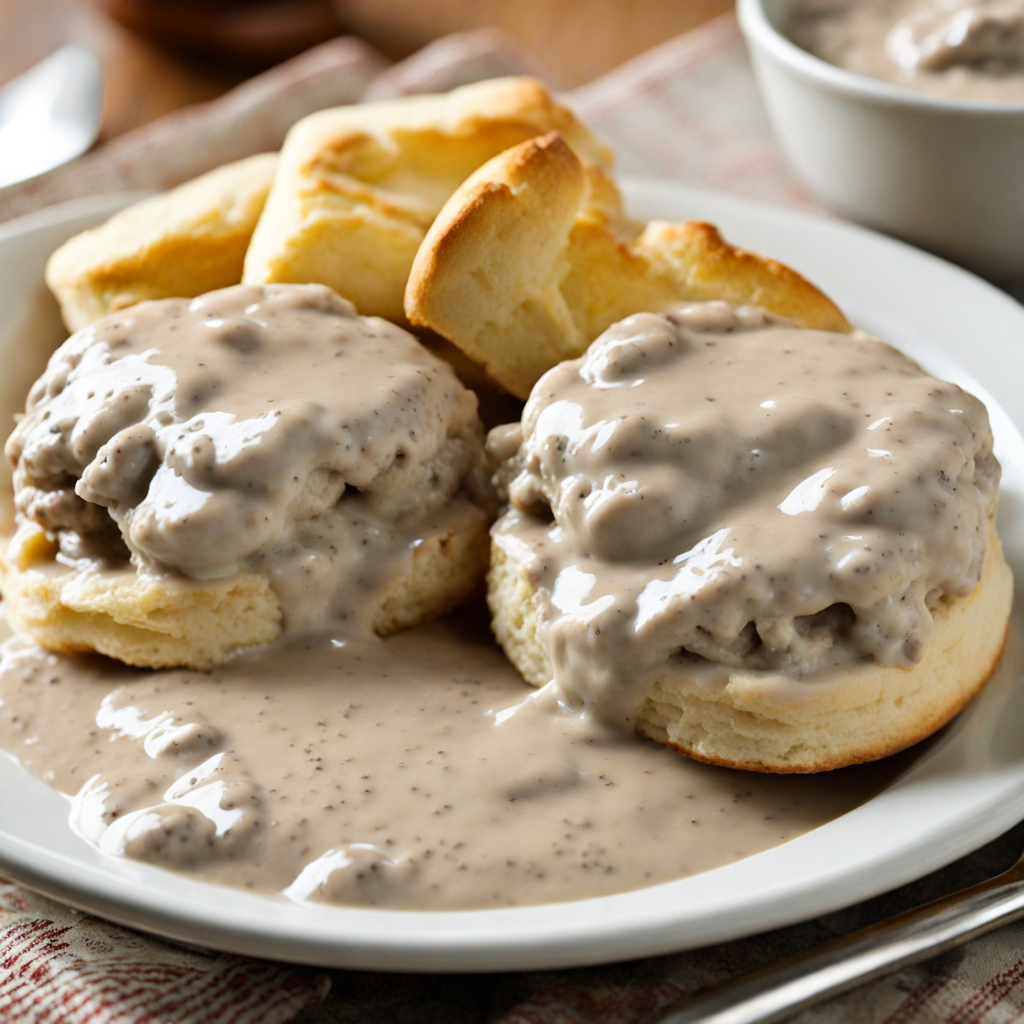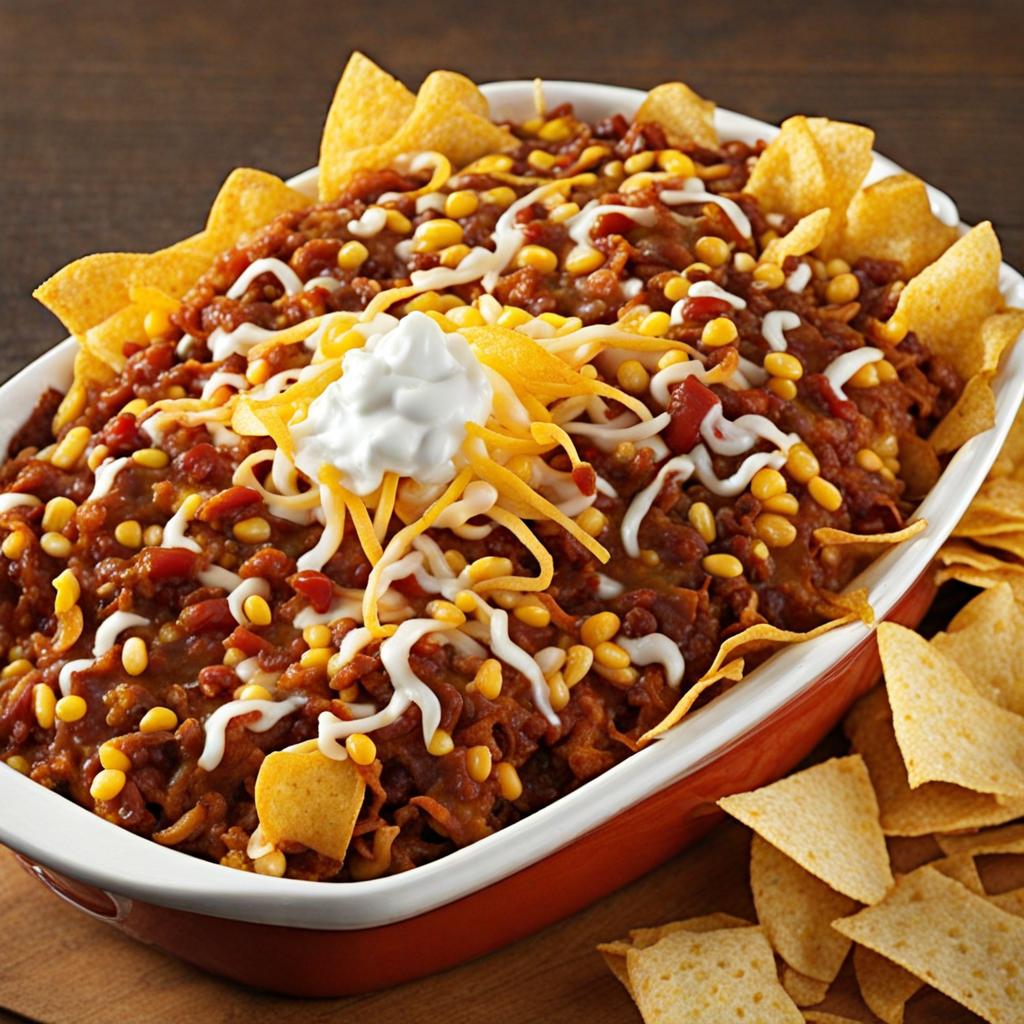Biscuits and Gravy
Biscuits and Gravy is a beloved dish in the United States, particularly in the southern regions, known for its hearty and comforting qualities. The dish features soft, flaky biscuits that are typically made from scratch, using a combination of flour, baking powder, butter, and milk. These biscuits are often baked until golden brown, creating a tender interior with a slightly crispy exterior. The ultimate goal is to achieve a texture that allows them to easily soak up the rich gravy that accompanies them, making each bite a delightful experience. The gravy is the star of the show, often made from a base of pan drippings from cooked sausage, which lends a savory depth to the dish. This sausage gravy is thickened with a roux and then enriched with milk or cream, resulting in a creamy, luscious sauce that is both indulgent and satisfying. The addition of seasonings like black pepper, garlic powder, and sometimes even a hint of cayenne pepper adds a subtle kick, perfectly complementing the mild flavor of the biscuits. The combination of the flavorful gravy and the fluffy biscuits creates a comforting, soul-warming meal that is often enjoyed for breakfast or brunch. Served hot, Biscuits and Gravy is not just a dish but a culinary experience that embodies the essence of southern hospitality. It’s often garnished with a sprinkle of fresh herbs or served alongside fried eggs to elevate the meal. Whether enjoyed in a cozy diner or made at home, this dish evokes a sense of nostalgia and warmth, making it a favorite for many looking to indulge in a taste of American comfort food. Each bite is a delicious reminder of the rich culinary traditions that define this iconic dish.
How It Became This Dish
Biscuits and gravy is a quintessential dish of Southern cuisine that has become a beloved comfort food across the United States. This hearty dish typically consists of soft, flaky biscuits smothered in a rich, creamy gravy, often made with sausage. Its origins are deeply rooted in American history, reflecting the culinary traditions of various cultural influences and the socio-economic conditions of different eras. Origins The story of biscuits and gravy begins with the biscuit itself, which has its roots in the British scone. When English settlers arrived in America, they brought with them the method of making biscuits, which were initially baked as a quick bread. Over time, this recipe evolved, particularly in the Southern United States, where the use of buttermilk and lard became prominent, resulting in the light and flaky texture we recognize today. In parallel, the gravy component of the dish can be traced back to the practice of using leftover meat drippings to create a sauce. This practice was common in many cultures, but in the American South, it took on a unique character. Sausage gravy emerged as a particularly popular variant, made from the pork sausage that was widely available and affordable in rural communities. As the economy of the South transitioned post-Civil War, the biscuit and gravy combination became a staple breakfast item, reflecting the resourcefulness of people who needed to make the most of limited ingredients. Cultural Significance Biscuits and gravy symbolize more than just a breakfast option; they represent a cultural artifact of Southern hospitality and comfort. The dish is often associated with family gatherings, Sunday brunches, and diners where it is a common offering on the menu. Its preparation is often a communal activity, with families coming together to bake biscuits and whip up the gravy recipe passed down through generations. The dish also carries socio-economic implications. During the Great Depression, biscuits and gravy became an affordable meal for many families. The ingredients were inexpensive and accessible, allowing families to fill their bellies without breaking the bank. In this way, biscuits and gravy became a symbol of sustenance and survival, embodying the resilience of the American spirit during tough times. Development Over Time As the 20th century unfolded, biscuits and gravy began to evolve into the iconic dish we know today. The post-World War II era saw a surge in the popularity of diners and roadside cafes, where biscuits and gravy became a staple breakfast offering. The combination of quick service and hearty portions made it a favorite among travelers and locals alike. The dish gained further recognition in the 1970s with the rise of Southern cooking and the emergence of comfort food as a culinary trend. Chefs began to experiment with the traditional recipes, incorporating new ingredients and techniques. For instance, the introduction of spicy sausage, cheese, or even chorizo gravy began to appear on menus, reflecting the growing diversity of American cuisine. In the late 20th and early 21st centuries, the trend of “gourmet comfort food” brought biscuits and gravy into fine dining establishments. Chefs sought to elevate the dish, utilizing artisanal ingredients and creative presentations. Variations like buttermilk biscuits topped with wild mushroom gravy or smoked sausage gravy began to emerge, showcasing the versatility of the dish while still honoring its roots. Regional Variations While biscuits and gravy are often associated with the South, the dish has found its way into the culinary fabric of various regions across the United States, each adding its unique twist. In the Midwest, for example, the dish is often heartier, with thicker gravies and a preference for country-style sausage. In the Pacific Northwest, fresh, locally sourced ingredients may be incorporated, such as seasonal vegetables or herbs, to give the dish a modern flair. The West Coast has seen the emergence of a health-conscious approach to biscuits and gravy, with variations that include gluten-free biscuits or vegan gravies made with plant-based ingredients. Meanwhile, in urban centers, food trucks and cafes have embraced the dish, serving it with a range of toppings such as poached eggs, avocado, or spicy jalapeños, catering to a more diverse palate. Modern Day In contemporary America, biscuits and gravy have solidified their place in the culinary landscape. They are featured prominently in breakfast menus across the country, from fast-food chains to upscale brunch spots. Social media has played a significant role in the resurgence of interest in the dish, with food bloggers and influencers showcasing their unique takes and recipes, further fueling its popularity. Moreover, the dish has become a symbol of cultural identity, particularly in the South. It is often celebrated during festivals and culinary events, where chefs compete to create the best version of biscuits and gravy, highlighting the dish's importance in American food culture. Conclusion Biscuits and gravy is more than just a dish; it is a reflection of the American experience, encapsulating history, culture, and community. From its humble beginnings as a way to utilize leftover ingredients to its status as a beloved comfort food, the evolution of biscuits and gravy tells a story of resilience, adaptation, and the enduring love of home-cooked meals. As it continues to evolve and inspire new generations of cooks and food lovers, one thing remains clear: biscuits and gravy will always hold a special place in the hearts and kitchens of many Americans.
You may like
Discover local flavors from United States







